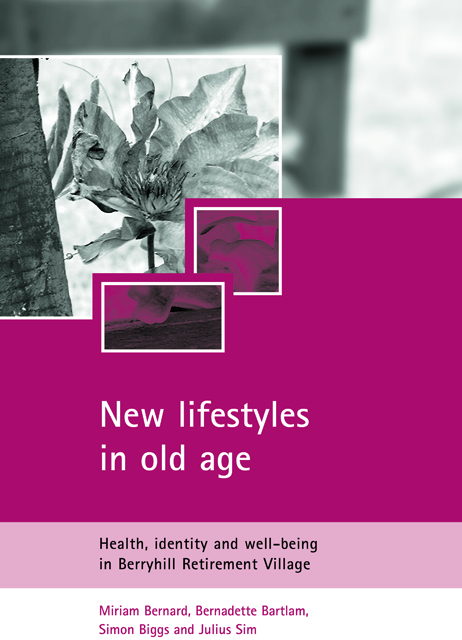Book contents
- Frontmatter
- Contents
- List of tables and figures
- Acknowledgements
- A day in the life of a retirement community resident
- 1 Retirement communities: the context
- 2 Developing a retirement community lifestyle: participation and involvement
- 3 Health and well-being
- 4 Growing older: age and identity
- 5 Conclusions
- References
- Appendix A Research questions
- Appendix B The study’s timeline
- Appendix C Questionnaires
- Appendix D Interviews
- Appendix E Participation groups and community conferencing
Appendix A - Research questions
Published online by Cambridge University Press: 06 April 2023
- Frontmatter
- Contents
- List of tables and figures
- Acknowledgements
- A day in the life of a retirement community resident
- 1 Retirement communities: the context
- 2 Developing a retirement community lifestyle: participation and involvement
- 3 Health and well-being
- 4 Growing older: age and identity
- 5 Conclusions
- References
- Appendix A Research questions
- Appendix B The study’s timeline
- Appendix C Questionnaires
- Appendix D Interviews
- Appendix E Participation groups and community conferencing
Summary
The study was guided by four main research questions and a series of subquestions:
1. What effect does the environment of Berryhill have on residents’ well-being?
(How does living in the village compare with previous living environments? What are the positive and negative aspects of this retirement community and how do they change over time? Does the environment facilitate or constrain the development of relationships? Does the environment enhance or impede residents’ sense of well-being? Does living in Berryhill affect residents’ access to support services/healthcare?)
2. What is the perceived health status of residents in Berryhill?
(What is the perceived health status of residents? How does this vary with perceptions of (a) the physical environment; (b) the ability to manage day-to-day activities; and (c) the nature of people’s relationships? How do perceptions of physical and mental health status change over time? How does this compare with population norms?)
3. How is a retirement community like Berryhill related to ageing identities and what strategies do residents adopt towards significant others?
(How do strategies change over time? Are different strategies adopted towards different groups of significant others? How are strategies related to ageing identities? How are strategies related to involvement in the village community? What is the relationship between strategies and perceptions of health status over time? What is the relationship between strategies and sense of well-being over time?)
4. How do stakeholders view life at Berryhill?
(How are issues of health, identity and well-being within the village viewed by families, staff, helping agencies and other community stakeholders? How do these views compare with the views of residents themselves?)
- Type
- Chapter
- Information
- New Lifestyles in Old AgeHealth, Identity and Well-being in Berryhill Retirement Village, pp. 63Publisher: Bristol University PressPrint publication year: 2004

